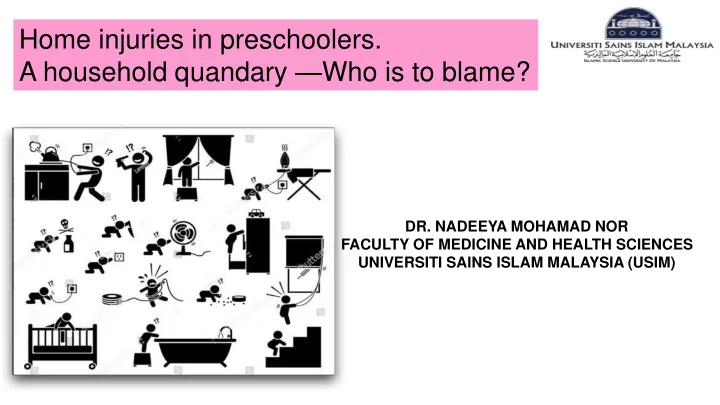

Home injuries in preschoolers. A household quandary — Who is to blame? DR. NADEEYA MOHAMAD NOR FACULTY OF MEDICINE AND HEALTH SCIENCES UNIVERSITI SAINS ISLAM MALAYSIA (USIM)
Introduction • injury and violence are the major cause of death in children and young people (under 18) • 90% accounts for Unintentional injury (falls, burns, road traffic injury, drowning & poisoning). • burden of injury highly noticeable among the lower and middle income countries
Findings from National Health Morbidity Survey (NHMS) Malaysia, • In Malaysia, injury at home ranked second to motor-vehicle accident (NHMS 2006). • Prevalence was higher among preschool children (NHMS 2011) despite the fact that the home is considered to be a safe place for them.
Impacts of injury (Polinder et al. 2005): • prolonged psychosocial implications that can affect both child and the caretaker. • decrease in quality of life, social relations and learning ability
Contributing factors to Preschool Unintentional Injury (PUI) (Garzon 2005)
Objectives • TO DETERMINE PREVALENCE OF HOME INJURY AMONG CHILDREN AGED 1-4 YEARS OLD LIVING IN THE URBAN AREA. • TO EXAMINE MATERNAL AND CHILD FACTORS THAT PREDICT HOME INJURIES IN CHILDREN.
Methodology Cross sectional study design Simple random sampling technique was used to select 5 Maternal and Child Health (MCH) clinics in the Urban area of Kuala Lumpur 500 mothers of children aged 1-4 years attended selected MCH Clinics agreed to be the respondents Guided self-administered questionnaire Primary outcome: Home Injury among children aged 1-4 years Factors studied: Sociodemographic characteristics, Mothers’ Knowledge towards home injury, Mothers’ Perception towards injury prevention, Mothers’ Injury Prevention practice, Mothers’ Parenting scale, Mothers’ Social support, Child injury proneness
Results
Maternal Characteristics Mean (SD) Age: 30.18 (4.5) years Figure 1: Distribution of marital status (N=500) Figure 2: Distribution of working status ( N=500 ) Figure 3: Distribution of level of education (N=500)
Child Characteristics Figure 4: Distribution of child’s age group (N=500) Figure 5: Gender distributions of the children (N=500) Mean (SD) score of child injury proneness: 22.80 (9.73)
Description on Other Factors studied • Knowledge towards home injury: Mean (SD) total score: 10.27 (2.21) • Perception towards injury prevention: Mean (SD) total score: 35.89 (4.74) • Injury prevention practice: Good practice: 373 (74.6%) Poor practice: 127 (25.4%) • Parenting practice among mothers: Over-Reactivity - Mean (SD): 3.70 (0.86) Laxness - Mean (SD): 3.65 (1.05) Hostile- Mean (SD): 2.19 (1.11) • Social support received by mothers: Spouse - Mean (SD): 5.26 (0.73) Family - Mean (SD): 5.20 (0.65) Friends - Mean (SD): 4.76 (0.74)
Prevalence of Home Injury in Preschoolers (1-4 years old) Figure 6: Distribution of Home injury in children (N=500) Figure 7: Distribution of type of injury (N=143)
Prevalence of Home Injury in Preschoolers (1-4 years old) Figure 8: Distribution of injured child according to gender Figure 9: Distribution of treatment to the injured child (N=143) (N=143)
Predictors of Home Injury in Preschoolers using Multiple Logistic Regression (MLR) Injured child Non injured Adjusted 95 % CI Variables P (N=143) child (N=357) OR Mother’s age, mean (SD) 28.74 (4.03) 30.76 (4.63) 0.857-0.955 <0.001 0.904 Injury prevention practice, n (%) 50 (3 9.4 ) 77 (60.6) 1.768 1.097-2.852 0.019 - Poor - Good 93 (24.9) 280 (75.1) Parenting style (laxness-type), 3.86 (0.83) 3.63 (0.87) 1.395 1.067-1.824 0.015 mean (SD) Social support (spouse), 5.31 (0.70) 0.405-0.986 5.12 (0.82) 0.632 0.043 mean (SD) Child gender, n (%) 99 (37.9) 1.469-3.672 <0.001 162 (62.1) 2.323 - Boy, - Girl 44 (18.4) 195 (81.6%) Child injury proneness, 26.03 (11.30) 1.014-1.062 21.51 (8.71) 1.038 0.002 mean (SD)
Discussion This study highlights, • Home injury among preschoolers is prevalent (28.6%), mainly among the boys (69.2%), with fall as the commonest type of injury. • Both Maternal and Child characteristics predict Home injury in preschool children. • Young mothers, poor injury prevention practices, lack of social support from spouse with a relaxed-parenting style predict child injury at home. • Being a boy and behaving towards injury prone also predict home injury among the children.
Recommendation 1) Identifying high risk family for targeted family intervention Hazard awareness & minimisation Supervise children, Anticipate child behaviour, avoid laxness-parenting Supportive family
Recommendation 2) Incorporating Module on Home Injury Prevention Programme during the premarital courses and also antenatal courses. 3) Educate and empower the children on behaviours that may expose them towards injury and how to prevent them.
Recommend
More recommend